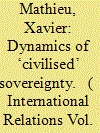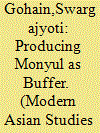|
|
|
Sort Order |
|
|
|
Items / Page
|
|
|
|
|
|
|
| Srl | Item |
| 1 |
ID:
163101


|
|
|
|
|
| Summary/Abstract |
Critical and post-colonial scholars have argued that a more complete account of sovereignty necessitates an exploration of the colonial experiences through which Western civilised identity was forged. But the way these ‘distant’ encounters were used in (and interacted with) the process of claiming sovereignty domestically has received less attention. This is surprising as critical scholars have revealed the existence of strong similarities between the domestic and international constructions of sovereignty (and in particular the necessary performance of a savage Other) and have emphasised how sovereignty transcends the domestic/international frontier and provides a crucial link between the two. As a response, this article develops an analysis of the construction of sovereignty that combines both the domestic and international colonial frontiers on which ‘civilised’ sovereignty relies. I use a large set of primary archives about France in the sixteenth century in order to explore how sovereignty depends on unstable colonial frontiers, that is, differentiations between the civilised and the savage, that are constantly contested and re-established. Combining the domestic and international colonial frontiers reveals how they interact and are used in order to reinforce the civilised identity of the Western ruler.
|
|
|
|
|
|
|
|
|
|
|
|
|
|
|
|
| 2 |
ID:
172007


|
|
|
|
|
| Summary/Abstract |
This article focuses on the Tawang and West Kameng districts of Arunachal Pradesh, northeast India, collectively known as Monyul. It was ruled by Tibet for three centuries before the 1914 McMahon Line boundary included it in India. Even after that, cross-border exchanges between Monyul and Tibet continued until the 1962 Sino-Indian war, following which border passages between the two were closed. Today, Monyul is a marginal region, geographically distant from centres of industry and education, and lacking in terms of infrastructure. This article traces Monyul's marginality not simply to the border war, but to spatial practices of the British colonial state, beginning with the mapping of the boundary in 1914. It shows how Monyul was constructed as a buffer, despite being within a delimited boundary, first, by excluding it from regular administration, and, secondly, by pushing back the older Tibetan administration, thereby, making it (what I call) a ‘zone of difference/indifference’. But the buffer project was subject to contestation, mostly from the Tibetan religious aristocracy, whose temporal hold over, and material interests in, Monyul were challenged by the latter's incorporation into colonial India.
|
|
|
|
|
|
|
|
|
|
|
|
|
|
|
|
|
|
|
|
|